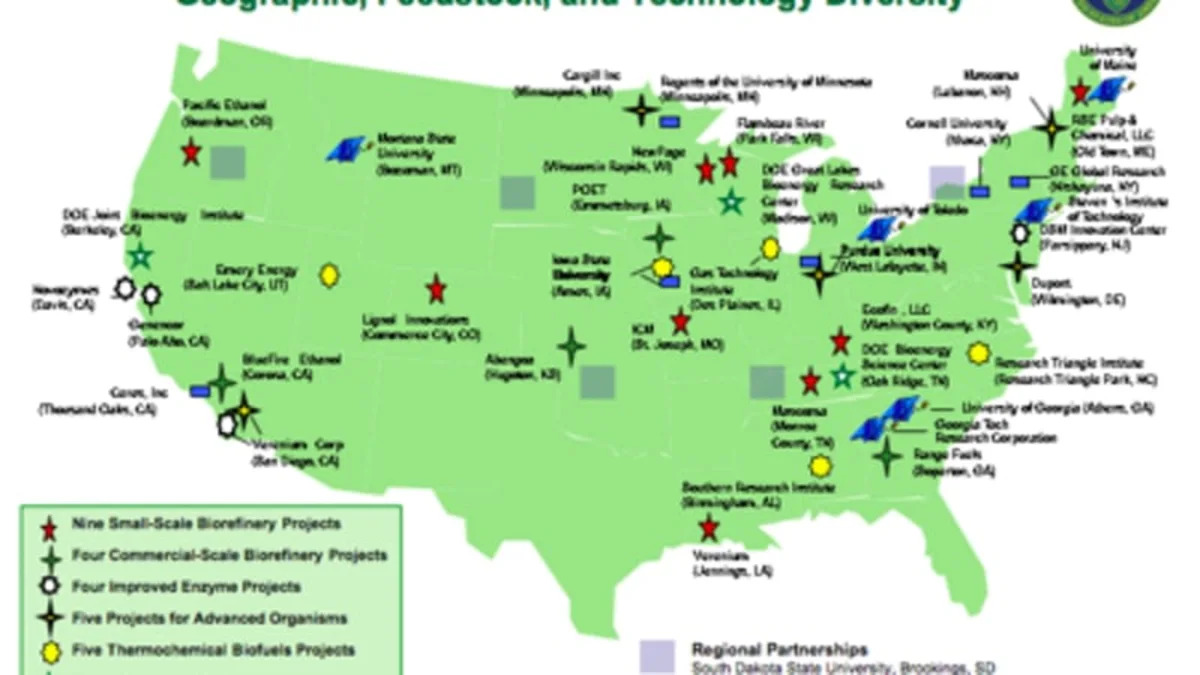click to enlarge
Representatives from the U.S. Department of Energy and the USDA were present at the Platts Cellulosic Ethanol conference in Chicago last week and put the national government's biofuel efforts into perspective. Valri Lightner, of the Biomass Program at the DOE, and William Hagy III, deputy administrator of business programs USDA Rural Development, each spoke for about 20 minutes and
Lightner said the DOE's Biomass Program mission statement is to find ways to use biomass to produce fuel, products and power. The short term goal is to have cost-competitive cellulosic ethanol (i.e., a cost of $1.33 to make a gallon by 2012), while the mid-term goal is to have sustainable biofuel production by 2017. There are a lot of bioenergy crop trials going on right now – switchgrass, sorghum, and more – as you can see in the map above and in this map. The DOE plans to help push down the cost of feedstock logistics from $60/dry ton to $46/dry ton by 2012. Meanwhile, the DOE also wants to lower the cost of biochemical conversion from $1.60 a gallon in FY 2007 to $0.82 in 2012. The department also announced last week that it will soon focus on pyrolysis.
This post continues after the jump.
Today, Lightner said, E85 accounts for less than one percent of the ethanol on the U.S. market and the E10 market will be saturated within a few years when the ethanol industry is able to produce approximately 14 billion gallons a year. Therefore, the has DOE initiated a testing program for intermediate ethanol blends to assess the viability of E15 and E20. The first interim report was issued on Tuesday and Lightner said the initial results were "promising."
Hagy, for his part, gave us an update on the status of the 2008 Farm Bill that passed in June and how it impacted the cellulosic ethanol industry, focusing on four bioenergy programs that are part of the Farm Bill.
Biomass Crop Assistance Program
BCAP gives payments to producers of renewable biomass crops, and not just the growers either, but the people who collect, harvest, transport and store it as well. This program is funded through 2012.
Biorefinery Assistance Program
BAP provides grants for demonstration scale and loan guarantees for commercial scale biorefineries that produce advanced biofuel. This program can give out up to $250 million, and will pay for up to 50 percent of the cost of each plant.
Bioenergy Program for Advanced Biofuels
BPAB gives payments to eligible producers to support and ensure expanded production of Advanced Biofuels. In the first two years (FY2009 and 2010), there will be $55 million available. This grows to $85 million in 2011 and $105 million in 2012.
Rural Energy for American Program (formerly known as the Renewable Energy Systems and Energy Efficiency Improvements Program)
REAP establishes a grant and loan guarantee program to assist agriculture producers and rural small businesses in purchasing renewable energy systems and making energy efficiency improvements. These can be biomass, wind, solar, geothermal, or, and this is new, tidal energy improvements. REAP also established a Grant Program for energy audits, technical assistance and feasibility studies and the federal share is capped at 75 percent of total project costs. REAP's mandatory funding is $55 million in FY2009, $60 million in 2010, and $70 million each in 2011 and 2012. Thus far, in FYs 2003 through 2007, the program has spent almost $200m on 1,412 projects.
Thanks to Lightner and the DOE for providing AutoblogGreen with the slides. Listen to Lightner and Hagy here (43 min):
The video meant to be presented here is no longer available. Sorry for the inconvenience.
Our travel and lodging for this event was provided by GM.



Sign in to post
Please sign in to leave a comment.
Continue